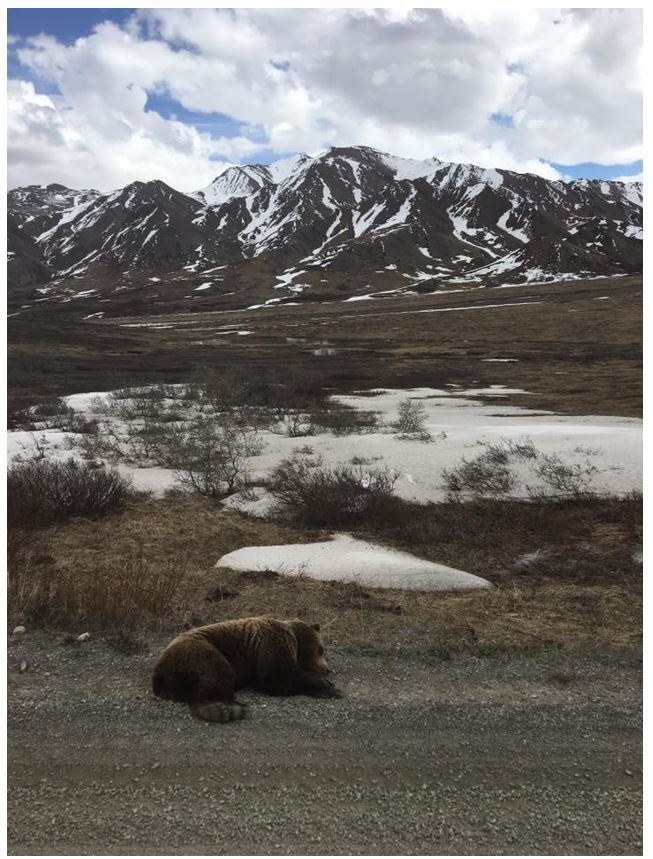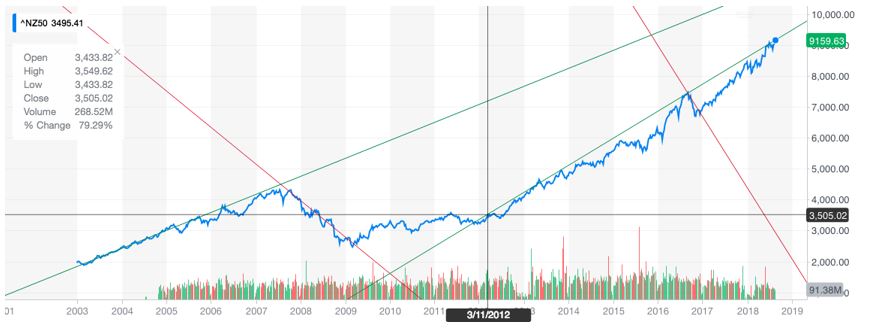Here in Alaska, we live alongside the wildlife. Moose and bears often wander into the cities…and it’s not unusual to spot a bull moose crossing the highway, surrounded by high rise apartments and buildings.
Although I’ve never seen a bear from my house, I have run into several moose chomping down on the raspberry bushes outside my front door.
Head out a kilometer or two from the city limits and you’ll find Dall sheep teetering on steep cliff sides…beluga whales surfacing near the shore…and bald eagles perched near salmon runs.
But the only predator we fear is the bear. We have two species here: black bears and their larger cousins, the grizzly bear.
 |
A napping grizzly bear in Denali National Park / Source: Taylor Kee |
Black bears tend to make their way into the cities more often than grizzlies…and they’re often the more aggressive of the two. And you wouldn’t want to play dead around them…the recommended response is to get big and loud…and if it comes to it — fight back.
Grizzlies on the other hand might leave you alone if you play dead. Even though Leo DiCaprio wasn’t so lucky in The Revenant.
At Money Morning New Zealand, we know bears — the economic kind. A bear market is one that’s sliding downhill. It’s a market where many investors lose their fortunes, homes, and jobs.
Fortunately, New Zealand’s lack of bears seems to have seeped into the world of money too.
New Zealand’s biggest bear
Here’s what New Zealand’s stock exchange has looked like over the past two decades or so:
 |
Source: Yahoo Finance |
The blue line is the value of the NZX 50. As you can see, bear markets (the red lines) are short lived…while the bull runs (green lines) keep climbing.
It’s a great time to be a Kiwi investor.
But lately, the number of red flags compels many to be skeptical of the current trends’ sustainability. Here are just a few issues we’re monitoring:
- The housing bubble
- Exceptionally high P/E ratios
- Long-term low interest rates
- Mismanaged state programs (See KiwiRail)
- The demographic time bomb
But for Bryan Gaynor, executive director at Milford Asset Management, these red flags are just red herrings. He looks back at the ’87 crash and the road leading to the crisis…and he’s determined that New Zealand today is a much better place.
He reckons any correction will be subdued. New Zealand’s biggest companies today are much healthier and more sustainable than those of the ‘80s and ‘70s. Gone is the era of speculation. Instead, we live in a time of solid growth (according to Gaynor). [openx slug=inpost]
In this NZ Herald article, Gaynor examines five factors:
- Performance
- Companies
- Governance
- Ownership
- Valuation
To Gaynor, today’s performance pales in comparison to the run up mania before the ’87 crash. And there’s some truth to that. He reports (emphasis mine):
‘The 2012 calendar year, when the NZX rose 18.0 per cent, has been the best year in the current cycle, while the market surged 116.8 per cent and 99.2 per cent in 1983 and 1986 respectively.’
Those numbers are hard to argue with. 116% growth in one year is insane. But we might suggest that 18% is crazy too. Especially when the rest of the world struggles to hit double digits. But yes, compared to 1983, today’s bubble isn’t as inflated.
He also mentions the quality of the businesses on the exchange. Thirty years ago, the composition of companies was more weighted towards forestry and investment firms. Today, the NZX is more diversified and sustainable.
That may be true, but many of the companies listed on the NZX 50 have significant assets tied up in the property market. If that disintegrates like we think it might, it could lead to massive losses across the whole market.
Governance is a strange point. Far more companies today have female leadership compared to the ‘80s. How that relates to the health of the market…I’m not sure.
His point about ownership is a little biased. He says that investors in the ‘80s were individual investors, not fund managers. They didn’t really know what they were doing…so their poor investment practices led to the fall of the economy.
Today, most investments are managed indirectly through fund managers (like Gaynor). To him, that means that investments today are more sustainable than they used to be.
We’re not so sure. We tend to think that individual investors are just as capable — if not more capable — than fund managers. But as a fund manager, Gaynor would disagree…of course.
His last point is on valuations. He recognizes that today’s P/E ratios far outstrip those of the ‘70s and ‘80s — 10x versus 26x today.
But Gaynor says, ‘…we should be careful with these figures because the 1980s forecasts were partly based on unsustainable capital profits that disappeared after the October 1987 crash.’
Substitute ‘unsustainable capital profits’ with ‘unsustainable property valuations’ and you’d have a fairly accurate picture of today’s situation. So I’m not so sure that the current market is much better off than it was three decades ago.
The truth is, we’re in a period of outstanding growth and repeat returns. The general market sentiment is positive…and threats to that growth are more or less pushed under the rug.
It’s a bullish investor’s environment. Most bears are hiding in their dens.
At Money Morning New Zealand, we hope that today’s bull run continues on forever…but we know that markets don’t work that way.
Eventually, the bear will show his fangs.
And the best thing we can do is to be armed and ready. Are you?
Best,
Taylor Kee
Editor, Money Morning New Zealand





Taylor Kee is the lead Editor at Money Morning NZ. With a background in the financial publishing industry, Taylor knows how simple, yet difficult investing can be. He has worked with a range of assets classes, and with some of the world’s most thought-provoking financial writers, including Bill Bonner, Dan Denning, Doug Casey, and more. But he’s found his niche in macroeconomics and the excitement of technology investments. And Taylor is looking forward to the opportunity to share his thoughts on where New Zealand’s economy is going next and the opportunities it presents. Taylor shares these ideas with Money Morning NZ readers each day.